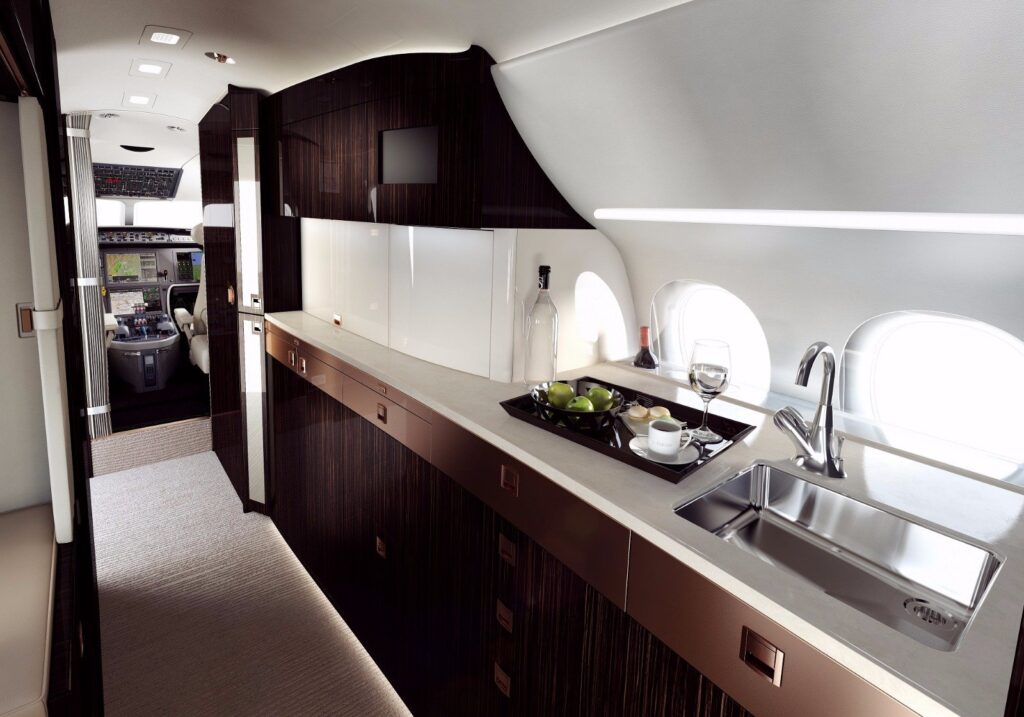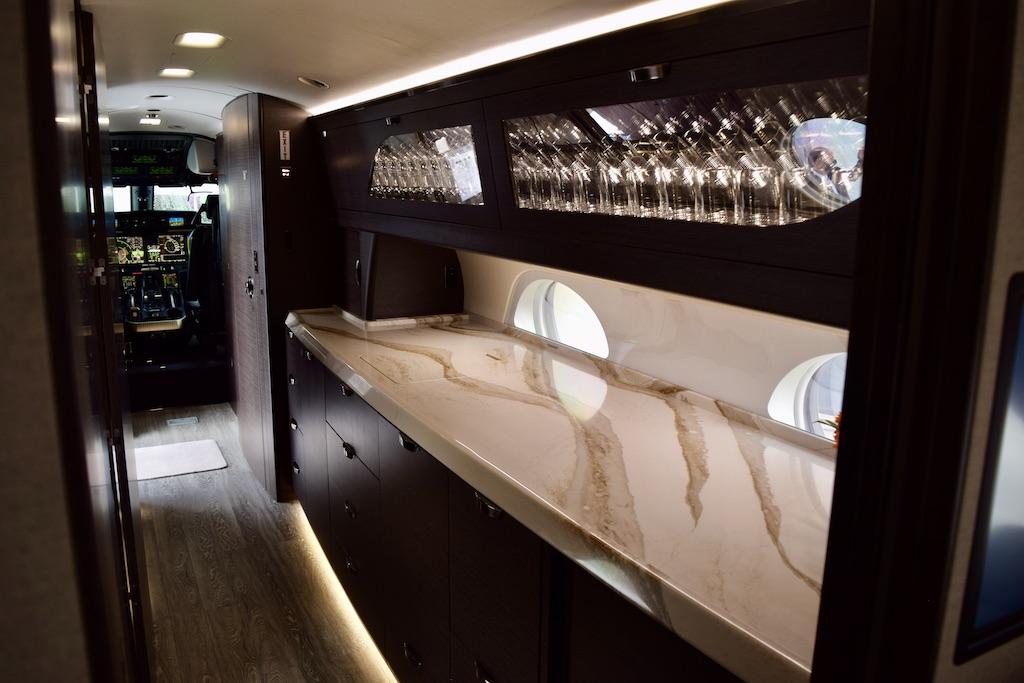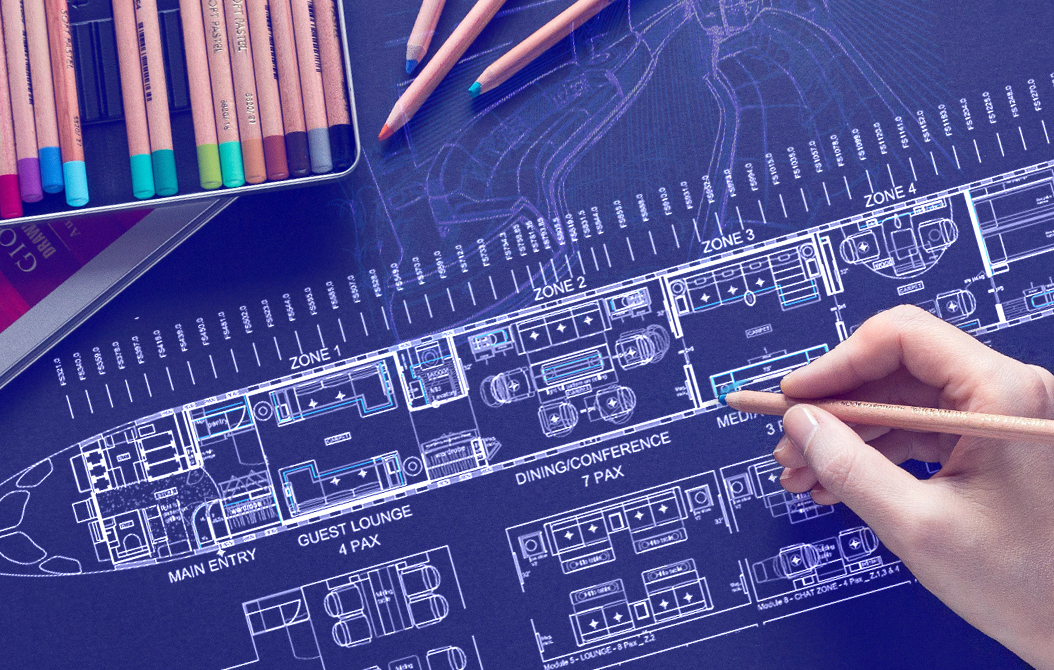A bespoke jet should be designed around the needs of its passengers – not the demands of the OEM. Whether you’re purchasing a new jet or a pre-owned jet, let’s explore how to better focus on the passenger experience when designing your ideal private aircraft…
It’s no secret that business aviation is in higher demand today than it has been since it’s inception. Flying privately and travelling with people you know is a great experience. Once you’ve tasted private aviation, you really don’t want to go back. Ultimately, a private jet is a significant investment for anyone, and an aircraft is purchased for specific reasons – the convenience, point-to-point travel and time saved is worth vastly more to a corporation, a head of state or a private investor than the financial investment of buying a private jet.
Given this, it’s essential that the aircraft fits your specific needs. If you require a space that supports productivity while allowing rest and relaxation for a specific amount of people to land fully energised and able to (almost literally) hit the ground running, then you’ll have certain requirements that are essential to meet to make the purchase of a private aircraft a wise decision.
If, on the other hand, family is your priority, then your jet may need to be much more personalised, incorporating features that are unique to you, your family, and your lifestyle. Or even, for many entrepreneurs, having a design that caters for a family-centric approach, whilst having the flexibility to provide a productive workspace allowing the jet to also be used for business purposes.
Therefore, it’s imperative that a jet be designed with the passenger in the centre, instead of compromising the passenger’s experience around the status quo. However, purchasing a private aircraft is a complicated process and there are several options. For example, you can buy a new jet and customise it according to the OEM options; alternatively, you could find a broker and purchase a pre-owned jet, then hire a designer and a team to customise it. Both options have their advantages – and their disadvantages.
Read on to explore how these options might work in the creation of your private aircraft and how there’s often a better way to design for the perfect passenger experience.
Option 1: Buying a new jet
The private aviation market is booming as the pandemic fades. According to AVBuyer, the wait time for new aircraft can be as much as 2-3 years and the sudden increase in new aircraft sales activity suggests the return of speculative buyers – a practice that dogged the early 2000’s business jet market. These speculative buyers order aircraft without any intention of actually flying their new jet, purely to sell their earlier delivery positions to time-constrained buyers for a hefty premium. However, OEM’s have been cautious about increasing production too quickly, wanting to see solid sales gains over time before making hefty financial commitments. (Source)
This means that buying a new private aircraft is not an exercise for the impatient. Regardless, let’s look at how this option offers buyers the opportunity to customise the aircraft to meet their specific requirements. When you buy a new aircraft in the large category (Gulfstream, Globals and Falcons) you’ll find that different aircraft are very similar in terms of layout. There’s a galley in the front and there’ll be a crew rest area tucked in somewhere to allow you to fly an additional crew member.
Dassault falcon 8X galley (source: Dassault-Aviation.com)

Gulfstream G700 galley (source: Aviationweek.com)

The passenger spaces look similar too – there’s often four single seats facing each other, generally a conference table that can also be called a dining table and in the back, there’s usually a divan and two seats. Alternatively, in the latest iterations, perhaps a permanent bed replacing the berthable divan, making for a much more comfortable sleep. Of course there are variations on all these options but the differences are generally slim – this is a fairly standard layout. There’s no doubt that Bombardier, Dassault and Gulfstream build aircraft with features that make them attractive to lots of different buyers but from a floor plan perspective they’re very similar. The question is, why?
Remember the booming aviation market? OEM’s have a backlog and, as such, don’t need to bend over backwards to cater to their clients. In the current market, their primary focus will be manufacturing speed and efficiency, fulfilling their order backlog to maximise profits. This means that OEM’s will limit options to make their products more homogenous while simultaneously making it easier and quicker to build.
And so, with this option the new owner gets a beautiful new airplane with an interior selected from an OEM catalogue. It will incorporate the latest technology systems and well-engineered fixtures with stylish finishes and materials from one of several default floorplan layouts. All beautiful choices but standard options – not unique or truly customised to your needs.
This is why OEMs prefer not to individualize aircraft beyond the catalogue – although you won’t necessarily be told this upfront. If you ask for specific customizations, the likelihood is that the manufacturer will be politely enthusiastic before quoting a mind-blowingly huge sum of money for the changes. If the bill is paid for, the changes will be made – but it’s not in the OEM’s interest to step outside their efficient (read, standardised) manufacturing process without charging a huge premium. Unfortunately, the client carries the cost of this.
So, even as the idea of a brand-new private jet is desirable, it requires a lot of patience and there will be compromises in creating a layout catered to your specific needs. It’s a good option for many buyers, but there are better ways forward.
Option 2: pre-owned jets
The private aviation boom and OEM waitlist has had a knock-on effect on the pre-owned market. According to Bombardier’s 2022 Pre-owned Market Report, there’s a historically low level of market saturation, with their pre-owned aircraft availability dropping by 92% in Q2 2022. (Source)
With this limited supply on the market, and private jet ownership continuing to rise sharply, it’s often a seller’s market. This means that pre-owned aircraft brokers will offer you what’s available on their books, rather than the specific jet you want. Indeed, many owners have been snapping up the first available aircraft and choose to customise the interior as best they can, instead of waiting long periods for specific models to become available.
Regardless, buying a pre-owned aircraft can be a shrewd move. Not only does it significantly reduce the wait-time, but a pre-owned aircraft can be reconfigured and refurbished to meet a new owner’s particular needs to a level that OEMs are unwilling and, inevitably, unable to provide. This customisation can vary greatly in scale and ambition.
For example: you may like the existing design of the aircraft and seek only to change the material finishes, or even just restore and upgrade the existing interior – finessing only a few details to your personal satisfaction. However, there’s also the opportunity to do something very different and completely redesign the interior to meet your requirements. You’ll need to find a designer whose work aligns with your tastes and your needs. That can be a challenge – the best designers have limited availability and will often prefer projects that give them a new or exciting challenge or add a prestigious project to their portfolio. Layouts designed for comfort and functionality might be your primary concern but it’s not always the most thrilling in terms of cutting-edge design concepts.
However, if you can find a good designer who understands your requirements and is in sync with your sense of style, you can get some really unique customisations that aren’t available when buying a new aircraft from an OEM. Apart from the limitations of the only available pre-owned aircraft you were able to initially find, you can have a jet tailored far more closely to your needs.
Thus, exploring the pre-owned option, we’re able to get closer to the optimal passenger experience but there are still compromises: the pre-owned aircraft broker wants to sell the jets he has available, although it might not perfectly match your requirements. The designer wants to design a beautiful interior for you – but they’re restricted by the choice of aircraft and may have to make compromises without fully understanding your functionality requirements.
Simply put: when buying a private jet, most of the vendors you’ll deal with will give you their best possible service – taking into account their own limitations and their own business concerns – which can often result in compromises.
But, once again, there’s a better way forward. Instead of giving money to manufacturers, brokers, designers, engineers and hoping that your priorities align with theirs; another option is to hire a representative whose only role is to make sure your requirements come first. Someone who can navigate the minefield of options, availability, regulations and conflicting priorities to make sure all your requirements are met without these types of compromise.
Option 3: completion management
A completion management team are a group of experts without any conflicting interests, able to objectively represent you throughout the aircraft selection, outfitting and customisation processes. This is not to be confused with completion centers who have their own facilities to carry out customisations and are, therefore, as subject to their own business concerns as aircraft brokers or OEM’s.
A completion manager is expert in the new and pre-owned private aircraft market with business connections to multiple different brokers, manufacturers, completion centers and designers. This means they’re able to select the best possible vendors to align with your priorities, removing the need to compromise with a designer who might not share your sensibilities or a broker with a limited portfolio.
However, the single best way to achieve the perfect passenger experience is to take several steps back to the beginning of the process and consult a completion manager before even deciding on the type of aircraft you wish to purchase. The perfect design starts at the first discussion with an expert advisor, who will invest time into understanding your expectations, your requirements, timeframe and budget – important information to be sure but these are basic logistics.
Although, before recommending aircraft, brokers or designers, a good completion manager will invest time into understanding you as a person. This means finding ways to completely define what it is you want from a passenger experience perspective, even if this is something you haven’t fully articulated yourself yet.
Initial conversations should revolve around subjects that may perhaps seem a little touchy-feely but actually provide a wealth of information to move onto the next steps. For example, finding out what your favourite car is, the best stay you’ve ever had in a hotel, your ideal method of travel, your favourite smells or colours, even down to your dreams or emotions. These preferences and reactions are primal and may not seem overly important but overlooking them can result in an aircraft that is technically perfect – on paper – but may offer an unfulfilling passenger experience, leaving the owner unsatisfied. Taking the time to understand a client means the completion manager can deliver a complex project by choosing the right team of professionals, including the right designer and a good outfitting team, to achieve incredible results.
Without this underlying knowledge and without the right team, possibilities may be missed, costs may exceed what you’re expecting and timelines will inevitably be exceeded. Using a professional completion manager to help you select the best aircraft, from finding the right broker to putting the perfect team in place to help plan, design and realise your perfect jet, means that you don’t have to work around other people’s priorities.
Buying a jet is a significant financial and time-consuming investment, so why compromise?
Coming soon, Part 3 of designing for the passenger experience explores the limits of what’s possible in terms of design and innovation

